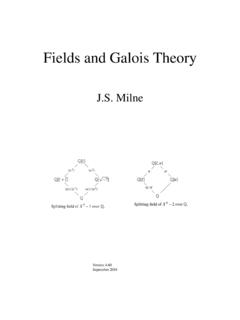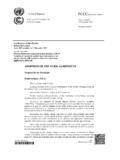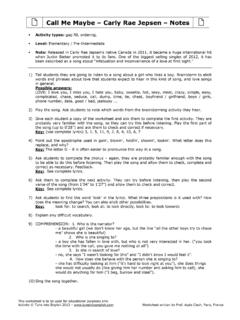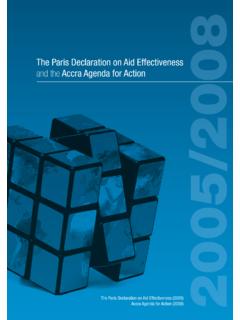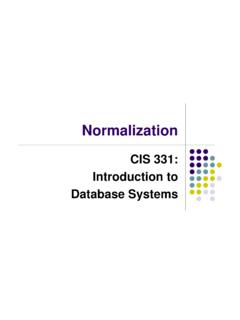Transcription of CLASS FIELD THEORY - James Milne
1 CLASS FIELD the notes for Math 776, University of Michigan, Winter 1997, slightlyrevised from those handed out during the course. They have been substantiallyrevised and expanded from an earlier version, based on my notes from 1993 ( ).My approach to CLASS FIELD THEORY in these notes is eclectic. Although it is possibleto prove the main theorems in CLASS FIELD THEORY using neither analysis nor cohomology,there are major theorems that can not even be stated without using one or the other,for example, theorems on densities of primes, or theorems about the cohomologygroups associated with number fields. When it sheds additional light, I have nothesitated to include more than one proof of a heart of the course is the odd numbered chapters. Chapter II, which is on thecohomology of groups, is basic for the rest of the course, but Chapters IV, VI, andVIII are not essential for reading Chapters III, V, and VII. Except for its first section,Chapter I can be skipped by those not interested inexplicitlocal CLASS FIELD of the form Math xxx are to course notes available send comments and corrections to me at including CLASS FIELD theoryArtin, E.
2 , Algebraic Numbers and Algebraic Functions, NYU,1951.(ReprintedbyGordon and Breach, 1967).Artin, E., and Tate, J., CLASS FIELD THEORY . notes of a Seminar at Princeton,1951/52. (Harvard University, Mathematics Department, 1961; Benjamin, 1968;Addison Wesley, 1991).Cassels, , and Fr ohlich, A., (Eds), Algebraic Number THEORY , Academic Press, , , and Vostokov, , Local Fields and their Extensions, AMS, , , Analytic Number THEORY , Prentice Hall, , K., Local CLASS FIELD THEORY , Oxford, , S., (ed.), The THEORY of Numbers, North-Holland, , , Algebraic Number Fields, Academic Press, 1973; Second Edition, AMS, , H., Number THEORY II, Algebraic Number THEORY , Springer,1992.(Ency-clopaedia of Mathematical Sciences, Vol. 62, Parshin, , and Shafarevich, ,Eds).Lang, S., Algebraic Number THEORY , Addison-Wesley, , J., CLASS FIELD THEORY , Springer, , J., Algebraische Zahlentheorie, Springer, , J-P., Corps Locaux, Hermann, 6, 1997; 1996, 1997, Milne . You may make one copy of these notes for your own , A.
3 , Basic Number THEORY , Springer, articles of Serre and Tate in Cassels and Fr ohlich 1967, and Janusz 1973, havebeen especially useful in the writing of these including an introduction to CLASS FIELD theoryCohn, H., A Classical Invitation to Algebraic Numbers and CLASS Fields, Springer, , , Primes of the Formx2+ny2: Fermat, CLASS FIELD THEORY , and ComplexMultiplication, Wiley, , D. A., Number Fields, for the history of algebraic number THEORY and CLASS FIELD theoryEdwards, , Fermat s Last Theorem: A Genetic Introduction to Algebraic Num-ber THEORY , Springer, , W. and F., Th eorie des nombres, in Abr eg e d Histoire des Math ematiques1700 1900, Vol I, (J. Dieudonn e, ed.) Hermann, Paris,1978, pp 165 , J., Le D eveloppment Moderne de la Th eorie des Corps Alg ebriques CorpsdeClassesetLoisdeR eciprocit e, Gauthier-Villars, Paris, , , Report on the the THEORY of Numbers, Reports of the British Associ-ation,1859/1865. (Reprinted by Chelsea, New York, 1965.)Weil, Number THEORY : An Approach Through History, Birkh auser, : Hasse s article in Cassels and Fr ohlich 1967.
4 Appendi x2 in Iyanaga s appendi xto the Collected Papers of Teiji Takagi. Tate s article Problem9: The general reciprocity law inMathematical Developments Arising from Hilbert sProblems, AMS, 1976. Weil s article, Oeuvres1974c. N. Schappacher, On the historyof Hilbert s twelfth problem (preprint). P. Stevenhagan and Lenstra, Chebo-tar ev and his density theorem, Math. Intelligencer, ,1996, 26 an introduction to nonabelian CLASS FIELD THEORY : Arthur s article in1980 Sem-inar on Harmonic Analysis, CMS Conference Proceedings Vol 1, AMS, :For a ringR(always with 1),R denotes the group of invertibleelements. We useXdf=Yto mean Xis defined to beY or X=Yby definition ,X Yto mean thatXandYare isomorphic, andX =Yto meanXandYareisomorphic with a given (canonical, or unique) of the main problem, 1; Classification of unramified abelian extensions,2; Classification of ramified abelian extensions, 2; The Artin map, 4; Explicit classfield THEORY , 6; Nonabelian CLASS FIELD THEORY , 6; Exercises, I.
5 Local CLASS FIELD Theory91. Statements of the Main Theorems9 Consequences of Theorems and , 11; Outline of the proof of the main theo-rems, Lubin-Tate Formal Group Laws15 Power series, 15; Formal group laws, 16; Lubin-Tate group laws, Construction of the extensionK local Artin map, The Local Kronecker-Weber Theorem30 The ramification groups ofK ,n/K, 30; Upper numbering on ramification groups,31; The local Kronecker-Weber theorem, 33; The global Kronecker-Weber theorem,35; Where did it all come from?, 36; notes , Appendix: Infinite Galois THEORY and Inverse Limits37 Galois THEORY for infinite extensions, 38; Inverse limits, 40;Chapter II. The Cohomology of Groups411. Cohomology41 The category ofG-modules, 41; Induced modules, 42; InjectiveG-modules, 43;Definition of the cohomology groups, 44; Shapiro s lemma, 45; Description of thecohomology groups by means of cochains, 47; The cohomology ofLandL , 49; Thecohomology of products, 52; Functorial properties of the cohomology groups, 52; Theinflation-restriction exact sequence, 55; Cup-products, 56;2.
6 Homology; the Tate Groups57 Definition of the homology groups, 57; The groupH1(G,Z), 59; The Tate groups,vviCONTENTS60; Cup-products, 61; The cohomology of finite cyclic groups, 61; Tate s Theorem,64;3. The Cohomology of Profinite Groups66 Direct limits, 66; Profinite groups, 67; notes , 69;4. Appendix: Some Homological Algebra69 Some exact sequences, 69; The language of category THEORY , 70; Injective objects,71; Right derived functors, 72; Variants, 75; The Ext groups, 75; References, 76;Chapter III. Local CLASS FIELD THEORY Continued771. Introduction772. The Cohomology of Unramified Extensions80 The cohomology of the units, 80; The invariant map, 81; Computation of the localArtin map, 83;3. The Cohomology of Ramified Extensions854. Complements87 Alternative description of the local Artin map, 87; The Hilbert symbol, 88; OtherTopics, 89; notes , 89;Chapter IV. Brauer Groups911. Simple Algebras; Semisimple Modules91 Semisimple modules, 91; Simplek-algebras, 93; Modules over simplek-algebras,95;2.
7 Definition of the Brauer Group96 Tensor products of algebras, 96; Centralizers in tensor products, 97; Primordialelements, 97; Simplicity of tensor products, 98; The Noether-Skolem Theorem, 99;Definition of the Brauer group, 100; Extension of the base FIELD , 101;3. The Brauer Group and Cohomology101 Maximal subfields, 102; Central simple algebras and 2-cocycles, 104;4. The Brauer Groups of Special Fields107 Finite fields, 107; The real numbers, 108; A nonarchimedean local FIELD , 108;5. Complements110 Semisimple algebras, 110; Algebras, cohomology, and group extensions, 110; Brauergroups andK- THEORY , 111; notes , 112;Chapter V. Global CLASS FIELD THEORY : Statements1131. Ray CLASS Groups113 Ideals prime toS, 113; Moduli, 114; The ray CLASS group, 115; The Frobeniuselement, 117;CONTENTSvii2. DirichletL-Series and the Density of Primes in Arithmetic Pro-gressions1193. The Main Theorems in Terms of Ideals121 The Artin map, 121; The main theorems of global CLASS FIELD THEORY , 123; The normlimitation theorem, 125; The principal ideal theorem, 126; The Chebotarev DensityTheorem, 128; The conductor-discriminant formula, 129; The reciprocity law andpower reciprocity, 130; An elementary unsolved problem, 130; Explicit global classfield THEORY : Kronecker s Jugentraum and Hilbert s twelfth problem, 131; notes , 132;4.
8 Id`eles132 Topological groups, 133; Id`eles, 133; Realizing ray CLASS groups as quotients ofI,135; Characters of ideals and of id`eles, 137; Norms of id`eles, 139;5. The Main Theorms in Terms of Id`eles140 Example, 143;6. Appendix: Review of some Algebraic Number Theory144 The weak approximation theorem, 144; The decomposition of primes, 145;Chapter and the Density of Primes1471. Dirichlet series and Euler products1472. Convergence Results149 Dirichlet series, 149; Euler products, 152; Partial zeta functions; the residue for-mula, 153;3. Density of the Prime Ideals Splitting in an Extension1554. Density of the Prime Ideals in an Arithmetic Progression157 The Second Inequality, 162;Chapter VII. Global CLASS FIELD THEORY : Proofs1631. Outline1632. The Cohomology of the Id`eles164 The norm map on id eles, 168;3. The Cohomology of the Units1694. Cohomology of the Id`ele Classes I: the First Inequality1715. Cohomology of the Id`ele Classes II: The Second Inequality1746. The Algebraic Proof of the Second Inequality1757.
9 Application to the Brauer Group1808. Completion of the Proof of the Reciprocity Law1829. The Existence Theorem184viiiCONTENTS10. Appendix: Kummer theory187 Chapter VIII. Complements1911. The Local-Global Principle191nth Powers, 191; Norms, 192; Quadratic Forms, 192;2. The Fundamental Exact Sequence and the Fundamental CLASS 196 The fundamental CLASS , 199; The norm limitation theorem, 200;3. Higher Reciprocity Laws200 The power residue symbol, 201; The Hilbert symbol, 203; Application, 206;4. The Classification of Quadratic Forms over a Number Field207 Generalities on quadratic forms, 208; The local-global principle, 209; The classifi-cation of quadratic forms over a local FIELD , 210; Classification of quadratic forms overglobal fields, 213; Applications, 215;5. Density Theorems2166. Function Fields2187. Cohomology of Number Fields2188. More onL-series218 ArtinL-series, 218; HeckeL-series, 219; Weil groups and Artin-HeckeL-series, 220;A theorem of Gauss, FIELD THEORY relates the arithmetic of a number FIELD (or local FIELD ) to theGalois extensions of the FIELD .
10 For abelian extensions, the THEORY was developedbetween roughly 1850 and 1927 by Kronecker, Weber, Hilbert, Takagi, Artin, andothers. For nonabelian extensions, serious progress began only about 25 years agowith the work of Langlands. Today, the nonabelian THEORY is in roughly the state thatabelian CLASS FIELD THEORY was in 100 years ago: there are comprehensive conjecturesbut few proofs. In this course, we shall be concerned only with abelian CLASS of the main a finite extensionL/Kof number fieldsand a finite setSof prime ideals ofKcontaining all those that ramify inL,letSplS(L/K) be the set of prime idealspofKnot inSthat split completely inL, , such thatpOL= Piwithf(Pi/p) = 1 for alli. For example, ifL=K[ ] =K[X]/(f(X)) andScontains the prime ideals dividing the discriminant off,thenSplS(L/K) is the set of prime idealspsuch thatf(X) splits completely Galois, then SplS(L/K)has3density 1/[L:K], and it follows that SplS(L/K)determines4L. Thus the problem of classifying the Galois extensions ofKramifiedonly at prime ideals inSbecomes that of determining which sets of primes inKariseas SplS(L/K) for some quadratic extensionsL/Q, the answer is provided by the quadratic reciprocitylaw:Letmbe a positive integer that is either odd or divisible by 4, and letSbe a finite set of prime numbers containing all those that a subgroupHof (Z/mZ) of inde x2, letPr(H)={(p)|paprimenumber,p/ S,pmodmlies inH}.
